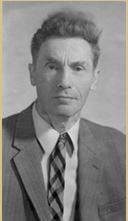
Viktor Tseitlin
Viktor Tseitlin was born in 1914 in the town of Monastyrshchina, western Russia. His father Solomon was a cabinet-maker. Viktor studied at a local Yiddish school, and in 1930 entered the theatre studio of the Moscow State Jewish Theater (GOSET), headed by Solomon Mikhoels, from which he graduated in 1934 as a stage director. From 1934 to 1939 he worked as a director at various provincial Yiddish theaters: in Tashkent, Central Asia (1935-1937), in Baku, Azerbaijan (1938-1939), and in Białystok, that was annexed by the Soviet Union in September 1939. In June 1941 he embarked on a tour with the Białystok theater to Lithuania and Belorussia, having left his four-year old son Eduard in Białystok with his nanny. While he was in Mogilev, Belorussia, Operation Barbarossa began.
As a theater director, Tseitlin realized that it was his duty to evacuate the Jewish theater. He succeeded in obtaining a heated railway car for the theater, and the theater collective eventually arrived safely in Tashkent. Within a short time Tseitlin was mobilized to guard a Gulag labor camp in Uzbekistan that had been established at a coal quarry Continually tormented by the fact that his son had remained in German occupied territory, Tseitlin repeatedly requested to be enlisted for frontline service. His third request was successful and in April 1942 he was summoned for a medical examination. To the first question of the physician "What problems do you have?" Tseitlin answered: "Hitler!"
Despite this, Tseitlin was not sent to the frontline immediately, but first to an artillery school that was located in the Saratov Region, on the Lower Volga. Since the school specialized in training soldiers to use self-propelled artillery, Second Lieutenant Tseitlin graduated as a commander of a self-propelled gun crew. In the summer of 1944, he was assigned to the 379th Heavy Self-propelled Artillery Guards Regiment, that operated on the 3rd Baltic Front and was then fighting in Estonia. In September 1944, during fighting for the Estonian-Latvian border town of Valga/Valka, he was seriously wounded. During an artillery duel with a German "Ferdinand" tank, his self-propelled gun was hit by an armor-piercing shell, and Tseitlin was wounded in the carotid artery, in addition to sustaining other wounds from shell fragments. His comrades assumed that he was dead and hastily covered him with earth. Since Soviet military regulations required that weapons and documents be taken from dead officers, after the battle Soviet personnel came to the location of Tseitlin's "body" and discovered that he was alive.
Tseitlin was treated in many hospitals and was operated on at least twice. His doctors managed to bring him back from the other world. In April 1945 he was released from his last hospital with the designation of a disabled veteran. At the end of 1944, Tseitlin learned that his son Eduard was alive and was residing in the Polish city of Białystok. With great determination, the father succeeded in overcoming Communist bureaucracy and having his son transferred from Poland to the Soviet Union.
In the summer of 1945 Tseitlin was awarded the Order of the Red Star.
After the war, Tseitlin settled in Tomsk, Western Siberia, where he was the director of a non-Jewish theater, and then the manager of other local cultural institutions. He died in Tomsk in 2003.






